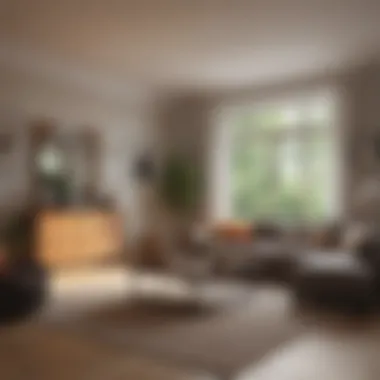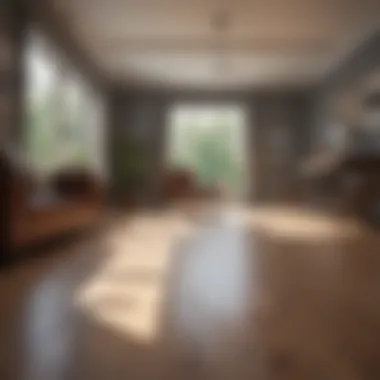Calculating Square Feet: A Complete Guide


Intro
Calculating square feet is essential for anyone involved in the realms of real estate, interior design, or home renovation. Accurate measurement enables homeowners to make informed decisions regarding space allocation, whether for flooring, furniture arrangement, or design aesthetics. Moreover, real estate professionals rely heavily on precise calculations for property valuations and listings.
In this exploration of square footage calculation, the focus will be on providing a structured understanding of measurement techniques. We will delve into various room shapes, explain practical methods, and highlight common errors that can lead to miscalculations. Additionally, this article aims to underscore the profound impact that accurate room measurements have on enhancing living spaces.
Let us embark on this educational journey to master the art of measuring square footage effectively and efficiently.
Preamble to Square Feet
Understanding square feet is vital for various stakeholders in the realm of real estate and design, including homeowners, interior designers, and property investors. The measurement of square footage determines how space is utilized in residential and commercial properties. This section introduces the basic concept of square feet, its utility, and why precise measurement is pivotal in effective space management.
Defining Square Feet
Square feet is a unit of area measurement commonly used in the United States and some other countries. It quantifies the total surface area within a room or building. A room measuring 10 feet by 10 feet would encompass 100 square feet. The calculation is fairly straightforward, yet its implications extend beyond mere numbers. Accurate square footage calculations influence various aspects of property management, such as pricing, renovation strategies, and interior design.
The significance of precision in these measurements cannot be overstated. Overestimating or underestimating square footage may lead to poor decision-making in purchasing materials or assessing property value. Familiarity with how to accurately define and calculate square footage equips the reader with a fundamental skill beneficial for both practical applications and investment considerations.
Importance of Accurate Measurements
Accurate measurements are not only about getting the numbers right; they are also key to successful project execution. Incorrect measurements can lead to overspending, wasted materials, or disappointing aesthetics in interior design. This accuracy is especially critical in projects where dimensions dictate functionality, such as buying flooring, creating layouts, or estimating costs.
Additionally, having a clear understanding of how to measure square footage opens doors for better communication between contractors, designers, and clients. It establishes a common language, reducing misunderstandings that might arise from vague descriptions or approximations. Furthermore, when looking at property transactions, accurate square footage is often a deciding factor that can affect the sale price and buyer interest.
"Measuring square footage accurately not only helps in space utilization but also enhances the overall experience of living or working in that space."
Basic Measurement Techniques
Understanding measurement techniques is fundamental to calculating square footage accurately. These techniques lay the groundwork for all subsequent steps involved in obtaining precise dimensions. Effective measurements are critical in various contexts, whether you are planning a renovation, arranging furniture, or assessing property value. Thus, knowing which tools to use and how to apply them is essential for achieving reliable results.
Proper measurement techniques can improve efficiency. They minimize the need for adjustments later in the planning process, which can save time and resources. By selecting the right tools and methods, you can ensure that the data you rely on is accurate and meaningful. Both traditional and modern methods have their benefits, and understanding when to apply each can enhance the quality of your measurements.
Another consideration is the consistency of measurements. Establishing a clear methodology reduces the likelihood of errors, leading to better outcomes for projects. A disciplined approach to measurement leads to enhanced professionalism, whether in a personal home improvement project or a commercial real estate appraisal.
Using a Tape Measure
The tape measure is a timeless tool for measuring distances. It consists of a flexible metal strip marked in inches and centimeters, allowing you to measure lengths, widths, and heights effectively.
Using a tape measure correctly involves more than just pulling it out and taking a quick reading. Here are a few important elements to consider when using a tape measure:


- Start from a Known Point: Always begin your measurement from a clear point. This ensures that your readings are accurate.
- Keep the Tape Straight: Prevent bends or curves in the tape as this can lead to inconsistent readings.
- Use a Helper if Necessary: For larger spaces, having someone assist can help keep the tape measure straight and reduce the chance of measurement errors.
Digital Measuring Tools
Digital measuring tools are increasingly popular for their accuracy and ease of use. These tools provide precise measurements at the touch of a button and often come equipped with features that traditional measuring tools lack.
Some benefits of digital measuring tools include:
- Precision: Digital tools often provide more accurate readings than manual tape measures, which can be prone to user error.
- Built-In Calculators: Many devices calculate square footage automatically, which streamlines the measuring process.
- Sound Feedback: Some tools emit sound when a measurement is taken, ensuring that you have captured the right data without the need to scrutinize the screen constantly.
Despite these benefits, it is essential to understand the limitations of digital tools. For example, they may require batteries or may not work effectively in certain lighting conditions. Furthermore, it is advisable to familiarize yourself with the device’s functions to maximize its effectiveness during measurement.
"Accurate measurements are the foundation of successful design & renovation projects. Investing in the right tools pays off."
Employing both traditional and digital techniques provides a comprehensive toolkit for anyone serious about accurate square footage calculations. Careful consideration of these measurement methods will significantly enhance your capacity to assess spaces effectively and confidently.
Calculating Square Footage
Calculating square footage is a fundamental practice in various fields, including real estate, interior design, and home improvement. Understanding how to accurately measure square footage contributes to informed decisions about space utilization. In this article, we will detail various techniques to calculate square footage based on different room shapes. Moreover, we will explore the benefits of accurate measurements and the considerations that must be made when interpreting these calculations.
This knowledge is crucial for anyone who is looking to optimize a living space for functionality or aesthetic appeal. Accurate square footage calculations can impact cost estimates for renovations, furniture layout designs, and even property valuations. Therefore, mastering this skill will enhance one’s ability to make informed choices in various contexts.
Rectangular Rooms
Length and Width
Length and width are the primary measurement dimensions for rectangular rooms. To find the square footage, you multiply these two values. This simple approach is beneficial because rectangles are common shapes in many homes and buildings, making the method widely applicable. The key characteristic of using length and width is its simplicity and ease of calculation.
However, overlooking precise measurements can lead to discrepancies in final square footage. If the measured length is slightly off, the entire area could be miscalculated. This hits the final goal of accurate measurement hard, leading to misplaced furniture or wasted flooring material. Accurate determination of length and width ensures that the calculation reflects the true dimensions of the room.
Calculating Area
Calculating area, specifically for rectangular rooms, stems directly from the length and width measurements. The area calculation involves multiplying the two dimensions, providing a straightforward result. This method is commonly chosen due to its accessibility; it requires minimal tools and can even be done manually if needed.
One unique feature of calculating area lies in its scalability. It can be applied regardless of the room size, whether tiny or vast. However, discrepancies in original measurements can alter the calculation significantly, making initial accuracy important. Miscalculating area might lead to incorrect estimates for expenses related to flooring or painting, which should always be avoided.
Irregularly Shaped Rooms
Dividing into Rectangles


When confronting irregularly shaped rooms, a practical method is to divide the space into smaller rectangular sections. This approach simplifies the measurement process, as it allows the user to find the area of multiple rectangles before summing them. This is an effective choice because it makes calculating square footage clearer and more manageable.
By breaking down complexities into simpler parts, one can adjust for irregular angles and curves without losing accuracy. Nonetheless, this method requires careful planning and organization to ensure that every section is accounted for correctly. If a portion is overlooked, the total square footage can be significantly off.
Adding Areas Together
After dividing an irregular shape for measurement, the next step is adding the areas of all sections together. This step is essential as it aggregates the total square footage of the room, offering a complete view of the space being analyzed. Adding areas together allows one to derive an accurate measurement for even the most complex layouts.
The big advantage here is that it applies to a range of room shapes and sizes. However, meticulous attention is needed in this process to avoid mistakes in addition. Miscalculating any single area can result in an error that compromises the overall accuracy of the square footage.
Circular Rooms
Understanding Radius
In circular rooms, the radius plays an instrumental role in calculating square footage. The radius, or the distance from the center of the circle to its edge, facilitates a different calculation compared to rectangular rooms. Understanding the radius is critical as it leads us to the area calculation for circular spaces. This method is favored for its precision in calculating spaces where straight edges do not apply.
However, capturing an accurate radius measurement can be tricky. Incorrect readings can heavily impact the area measurement, given the nature of the shape. Thus, attention to accuracy cannot be overstressed in this context.
Area Calculation Formula
The formula for calculating the area of a circular room utilizes the radius in a specific equation: Area = π × radius². This formula produces a precise depiction of the total square footage in circular layouts. The usage of this formula represents a rational choice for estimating area in unique room shapes.
Moreover, it provides an easily repeatable process for calculating other circular spaces, such as gardens or courtyards. However, reliance on π may introduce complications during calculations, particularly for those less familiar with mathematical constants.
Understanding the nuances of area calculation enhances the ability to utilize spaces effectively in any context, be it residential or commercial.
Practical Applications of Square Footage
Understanding square footage is essential for several practical applications that extend beyond mere calculation. Knowing the area of a room or a property can lead to informed decisions in design, budgeting, and functionality. When engaging in renovation projects, space management, or even real estate transactions, accurate measurements can significantly impact the outcomes. This section focuses on the practical applications pertinent to square footage, highlighting its relevance in various contexts.
Cost Estimation for Flooring
Cost estimation for flooring is one primary area where square footage matters. Knowing the square footage allows homeowners and contractors to determine how much material is needed. For instance, if a room measures 300 square feet, and a particular flooring type costs $3 per square foot, a simple multiplication will establish that the total cost for materials will be $900.
Additionally, accurate measurements help avoid over-ordering and under-ordering of materials. Over-ordering can lead to excess costs, while under-ordering may result in delays and increased expenses due to additional orders. Thus, precise square footage calculations facilitate proper budgeting and aid in making more economical choices.
Common Errors in Measurement
Accurate measurement is key when calculating square footage. Errors in measurement can lead to significant problems, from ordering too little flooring material to miscalculating space for furniture. Common issues need to be identified and avoided to ensure precision in any measurement task.


Overlooking Architectural Features
One of the most frequent errors in measuring square footage arises from neglecting architectural elements within a room. Features such as beams, alcoves, or built-ins often disrupt the traditional rectangular layout. Ignoring these can lead to a false sense of space. For example, what might seem like an open area could require more complex calculations due to these features taking up space.
When measuring, observe the room for such elements and factor in their impact. This not only affects calculations but can also influence design choices in future renovations. Consider the following factors:
- Beams and Columns: Measure the space around these structures to understand their influence on floor layout.
- Nooks and Al c oves: Ensure that these spaces are included in the calculation for a complete assessment of usable space.
- Doorways and Windows: Account for the areas they cover, which can alter total measurements.
Being vigilant about these details can refine overall accuracy significantly.
Incorrect Measurement Methods
Another critical source of error is the method used for measurement. Many people use inaccurate techniques or tools resulting in flawed calculations. The choice of measuring tools impacts the precision of results. Here are a few common incorrect methods:
- Using Poor Quality Tools: A tape measure that is warped or damaged can yield unreliable data.
- Relying Solely on Estimates: Rough estimates can seem tempting, but they often overlook minute details that skew numbers.
- Skipping the Re-check: Failing to measure a second time can mean overlooking early mistakes.
To ensure correct square footage calculations:
- Use high-quality measuring tools, such as a Stanley PowerLock Tape Measure.
- Take measurements from the longest points for accuracy, especially in irregular spaces.
- Always double-check measurements, especially if results will be used for ordering materials or planning layouts.
"Mistakes in measuring are avoidable but require diligence to prevent."
Understanding these common errors can guide homeowners and professionals alike in refining their measurements. Practicing accuracy in measurement ensures that design plans are executed flawlessly, enhancing the end result of any project.
Culmination
Understanding square footage is essential in various disciplines, including real estate, interior design, and home renovation. This final section underscores the value of precise measurements and their implications for making informed decisions.
The Value of Knowing Square Footage
The knowledge of square footage serves multiple benefits. First, it enables homeowners to assess the dimensions and proportions of their living spaces accurately. This allows for better planning in renovations or design projects. Additionally, knowing the square footage plays a crucial role in real estate. It helps in property valuation and can influence purchasing decisions. A larger square footage can command a higher price, while accurate measurements can help buyers avoid overpaying for a property.
Moreover, understanding square footage can optimize space usage. By accurately calculating the area, individuals can select appropriate furnishings, maximizing both functionality and aesthetic appeal. This information empowers homeowners and designers to make choices that enhance both comfort and style.
Encouragement to Measure Accurately
Measurement accuracy is not just a technical skill; it is a vital practice that reflects attention to detail. Measurement errors can result in costly mistakes, whether it is buying the wrong amount of flooring, misjudging furniture sizes, or undervaluing a property. Thus, it is imperative to approach measurements with care.
Here are some tips to encourage accurate measuring:
- Use reliable tools: Employ high-quality tape measures or digital measuring devices for precision.
- Double-check measurements: Always verify measurements by measuring twice or even three times.
- Account for unique features: Be aware of architectural details that may affect square footage calculations.
Accurate measurements allow for well-informed decisions in space planning and investment, enhancing overall satisfaction in one's living environment.
In summary, measuring square footage correctly is more than a benign task; it is an integral component of effective space management and financial prudence. Homeowners, designers, and real estate professionals must embrace the importance of accuracy as they navigate the complexities of space and dimensions.







